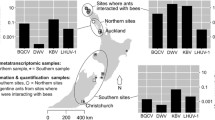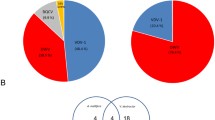Abstract
The complete genome sequences of two new iflaviruses (genus Iflavirus, family Iflaviridae) were determined. These viral sequences were first identified in RNA-seq contig sequences of Nilaparvata lugens in two distinct colonies: Izumo and Kagoshima. The accuracy of the contig sequences of the two viruses was verified by restriction enzyme digestion of RT-PCR products from viruliferous insects. RT-PCR of RNA extracted from honeydews after viruliferous insect feeding detected the expected viral products, which suggested that viruses were excreted into the honeydews by the insects. Since we previously designated a similar iflavirus as “Nilaparvata lugens honeydew virus 1”, the two new viruses have been tentatively named “Nilaparvata lugens honeydew virus 2” and “Nilaparvata lugens honeydew virus 3”. The identity of the putative amino acid sequences of the capsid proteins of these viruses met the criterion for iflavirus species demarcation. Therefore, these two viruses are suggested to be members of distinct species in the genus Iflavirus.


Similar content being viewed by others
References
Adams MJ, Carstens EB (2012) Ratification vote on taxonomic proposals to the International Committee on Taxonomy of Viruses (2012). Arch Virol 157:1411–1422
Chen YP, Nakashima N, Christian PD, Bakonyi T, Bonning BC, Valles SM, Lightner D (2012) Family Iflaviridae. In: Andrew MQK, Adams MJ, Carstens EB, Lefkowitz EJ (eds) Virus taxonomy, Ninth report of the International Committee on Taxonomy of Viruses. Elsevier, London, pp 846–849
Hofacker IL (2003) Vienna RNA secondary structure server. Nucleic Acids Res 31:3429–3431
Lanzi G, de Miranda JR, Boniotti MB, Cameron CE, Lavazza A, Capucci L, Camazine SM, Rossi C (2006) Molecular and biological characterization of deformed wing virus of honeybees (Apis mellifera L.). J Virol 80:4998–5009
Murakami R, Suetsugu Y, Kobayashi T, Nakashima N (2013) The genome sequence and transmission of an iflavirus from the brown planthopper, Nilaparvata lugens. Virus Res 176:179–187
Perera OP, Snodgrass GL, Allen KC, Jackson RE, Becnel JJ, O’Leary PF, Luttrell RG (2012) The complete genome sequence of a single-stranded RNA virus from the tarnished plant bug, Lygus lineolaris (Palisot de Beauvois). J Invertebr Pathol 109:11–19
Ryabov EV (2007) A novel virus isolated from the aphid Brevicoryne brassicae with similarity to Hymenoptera picorna-like viruses. J Gen Virol 88:2590–2595
Acknowledgments
We thank Tamaki Ichiki for providing the BPH Kagoshima colony. A part of this study was supported by JSPS KAKENHI Grant Number 225800062. Electron microscopy was supported by NIAS technical support.
Author information
Authors and Affiliations
Corresponding author
Additional information
The nucleotide sequence data reported are available in the GenBank database under accession numbers AB826459 and AB826460.
Rights and permissions
About this article
Cite this article
Murakami, R., Suetsugu, Y. & Nakashima, N. Complete genome sequences of two iflaviruses from the brown planthopper, Nilaparvata lugens . Arch Virol 159, 585–588 (2014). https://doi.org/10.1007/s00705-013-1850-0
Received:
Accepted:
Published:
Issue Date:
DOI: https://doi.org/10.1007/s00705-013-1850-0




